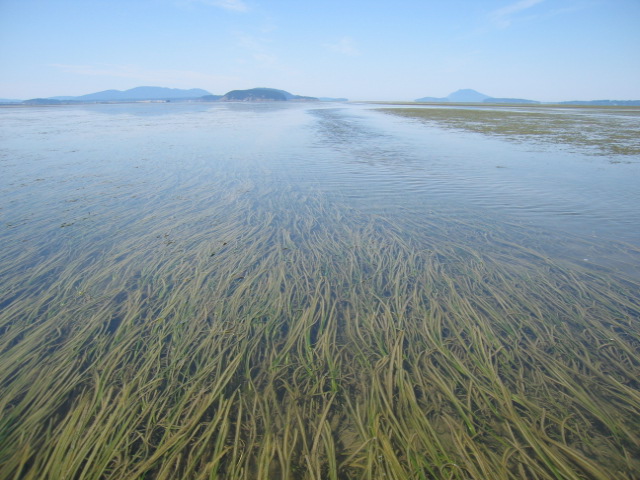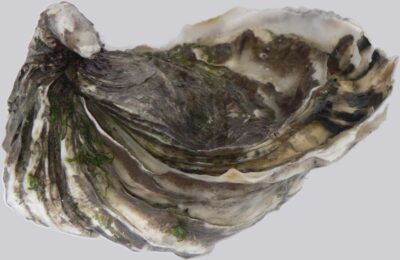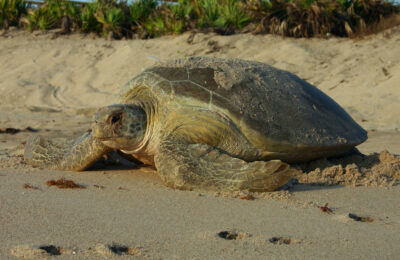Citation: Berger, A.C., Berg, P., McGlathery, K.J., Aoki, L.R., Kerns, K. 2024. Eelgrass meadow response to heat stress. II. Impacts of ocean warming and marine heatwaves measured by novel metrics. Marine Ecology Progress Series, 736:47 – 62, https://doi.org/10.3354/meps14588
With the summer season upon us, many people are reminded of both the joys and dangers of warmer weather. One or two hot days in a row can be enjoyable, but when we experience an onslaught of prolonged hot weather, like heatwaves, many people begin to suffer heat exhaustion and dehydration if they lack access to air conditioning, shade, bodies of water, or other ways to escape the heat. It seems that every summer, extreme heatwaves and heat-related deaths populate the news, and these reports are only expected to grow as climate change worsens. Extreme heat exerts stress on our bodies and our communities, and it turns out that natural ecosystems experience similar effects.
Marine Heatwaves Have Devastating Consequences
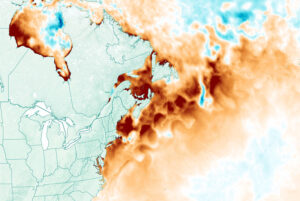
Heatwaves can impact all types of environments, including aquatic ones. Marine heatwaves happen when the water temperature rises to unsafe levels for fish and other aquatic life. Similar to heatwaves on land, marine heatwaves are intensifying and spreading with climate change. Many people have heard of coral bleaching, which occurs when corals are exposed to prolonged warm water temperatures, but the effects of marine heatwaves on other “foundation species” are less talked about. One of these species, which is crucial to building habitat and providing food for many other species, is eelgrass.
Eelgrass: Ecosystem Engineers and Carbon Superheroes
Eelgrass is a type of seagrass, which are the only flowering plants adapted to life in the sea. Like terrestrial grasses, seagrasses form meadows in coastal areas and they even sprout tiny flowers during springtime! As a foundational species, Eelgrass meadows function similarly to coral reefs by providing protected egg-laying habitat for many fish and invertebrate species, foraging grounds, and food for grazers like manatees. Eelgrass roots stabilize the sediment, which helps prevent coastal erosion, and can store an impressive amount of carbon, making eelgrass restoration a valid strategy for mitigating climate change.
Another similarity to coral reefs is the fact that eelgrass meadows can become stressed when exposed to heat for long periods of time. All organisms, including humans, have a range of temperature that is optimal for their health. When the environment is too hot, the human body sweats to attempt to cool itself. When the environment is too cold, we shiver to generate heat. When we are exposed to prolonged heat, the body becomes dehydrated from sweating and we may experience heat stroke and eventually death. Similarly, plants begin to dry out and die off when they are exposed to prolonged periods of heat outside their optimal thermal range. For aquatic plants, drying out isn’t a concern but prolonged time in hot water can overwhelm them just the same. When exposed to prolonged heat, eelgrass become stunted in their growth and eventually the meadow dies off in large patches. Due to all the benefits that eelgrass provides, the die-off of eelgrass meadows due to marine heatwaves has devastating consequences for marine life, carbon storage, and the safety of coastal communities.
Measuring Heat Stress in Eelgrass Meadows
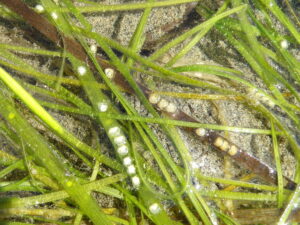
In June of 2015, a marine heatwave occurred off the coast of Virginia and caused a massive eelgrass die-off. This die-off was followed by a slow and patchy recovery, where some parts of the former meadow recovered faster than others. This eelgrass meadow is protected by the Virginia Coastal Reserve, which hosts one of the largest eelgrass restoration projects in the world. In fact, since 2001 over 70 million eelgrass seeds have been introduced to the reserve! Since this area is part of a marine reserve, where pollution is limited and water quality is high, it is a great place for researchers to study the effect of specific variables like heat on eelgrass meadows.
In a recently published study, researchers at the University of Virginia wanted to quantify the impact of ocean warming on seagrass meadows in terms of stress. They used two metrics to do this; cumulative heat stress, which they measured in “heat degree-hours” (aka: how hot for how long?) and heat stress relief, which they measured in “cooling degree-hours” (aka: how long to cool down?) relative to the known thermal tolerance threshold of eelgrass, which is a water temperature of 28.6 C or 83.5 F. Then, they compared these calculations to data on water and sediment temperature, and summertime eelgrass shoot density and length in the Virginia Coastal Reserve to understand how the seagrass meadows were recovering after the 2015 heatwave.
The researchers found that the parts of the meadow that recovered the fastest benefited from faster cooling due to tides that brought cooler water from the deep ocean over the shallow, overheated estuary during warm periods. This tidal cooling allowed the healthier eelgrass at the edge of the meadow to have 65% higher shoot density compared to the center of the meadow, which had less tidal cooling and experienced longer periods of heat stress, with shorter periods of relief. They also found that sediment temperatures were strongly affected by water temperature, so the movement of colder ocean water over the overheated estuary cooled the above-ground eelgrass blades and also cooled the sediment, which helped cool down the eelgrass roots and burrowing organisms like shellfish.
Another important finding of this study was related to the release of carbon dioxide, sulfide, and other potent greenhouse gasses, which occurs when bacteria in the water and sediment break down dead eelgrass enmasse after large die-offs like the 2015 heatwave. Prolonged heat stress and short periods of heat stress relief serve to hurt the ability of eelgrass to recover and also boost the growth of bacteria that are breaking down dead eelgrass material. This leads to more greenhouse gas emissions from the sediment and lower dissolved oxygen in the water, which suffocates fish and other aquatic life. Increasing tidal cooling, therefore, not only helps eelgrass recover from heat stress, but also decreases the amount of bacterial decomposition that occurs after a marine heatwave.
Mathematics to Save Eelgrass
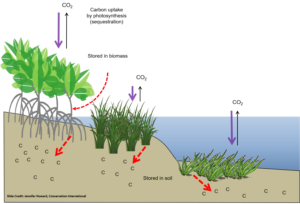
The researchers constructed equations to describe the relationship between heating and cooling degree hours and eelgrass growth in terms of shoot length and shoot density. They also found that the timing of heating events in the eelgrass meadows and the location of the eelgrass meadow with respect to tidal channels and open ocean water impacted the amount of heat stress experienced by the eelgrass meadow. Their results led them to the ultimate conclusion that a range of 100-200 C-hours was the amount of heat stress that could trigger a die-off of eelgrass during the growing season. The ability to mathematically display these complicated relationships is important for understanding how marine heatwaves impact eelgrass meadows all over the world, not just in Virginia. With the power of mathematics, researchers are able to generate models that can predict how a given eelgrass meadow might respond to a future heatwave in terms of eelgrass growth and the temperature of water and sediment, as calculated by the researchers in this study. These types of simulations will help natural resource managers protect eelgrass populations and target restoration efforts in response to heatwaves.
Cover Image: A healthy eelgrass meadow in Padilla Bay, Washington. Washington State Dept. of Ecology, Flickr.

I am a masters student at the University of Rhode Island, studying the ecology of the harmful algal bloom genus, Pseudo-nitzschia. My work is interdisciplinary and revolves around coastal health, water quality, and public engagement with science. In my free time I enjoy doing crafts, writing, cooking, and exploring the outdoors on my feet or a pair of skis.

